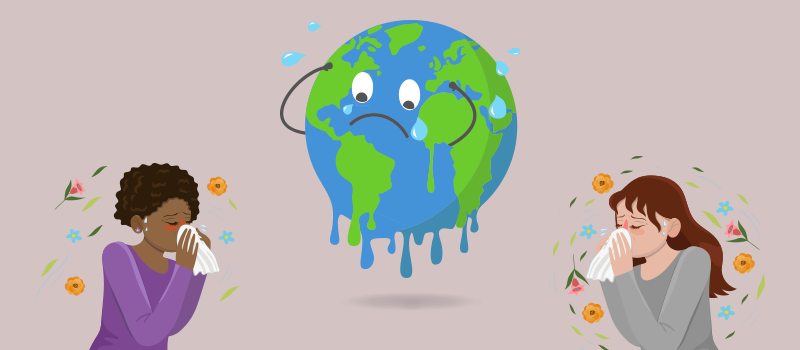What’s the Buzz
The Bee Healthy Blog
Pet Allergies in Babies and Children: What Parents Need to Know

Approximately 70% of households in the US, or some 90 million families, have pets. A furry friend completes the perfect family picture. Besides, a family dog (or cat) can teach a child so much — responsibility, trust, compassion, and patience.
But a family pet can also cause allergies in babies, children, and adults. The Asthma and Allergy Foundation of America estimates that 3 out of 10 people with allergies are allergic to cats and dogs.
Please continue reading to learn more about pet allergy symptoms in babies and children. Also, find out how doctors treat pet allergies in children and whether you need to remove a pet from your home to control your child’s allergy symptoms.
Why does a family pet cause allergies?
Allergic reactions occur when the body’s immune system perceives a normally harmless foreign substance as harmful and mounts an attack against it by making antibodies. The substances that cause allergic reactions are called allergens. In people with pet allergies, pet dander (skin flakes), urine, saliva, and sweat can act as allergens, triggering an allergic reaction. Also, an animal’s fur can collect dust, mold, and pollen, which are common allergens that cause seasonal allergies.
Allergic children have sensitive immune systems and are genetically predisposed to develop allergic reactions to things that don’t cause problems for other kids. That’s why some kids have an animal allergy, and others do not.
Are some pets more likely to cause allergy symptoms than others?
Cat dander is twice as likely to cause allergies as dog dander. While some breeds of cats and dogs are called hypoallergenic because they shed less fur and pet dander, there is no breed that is completely non-allergenic. Pet allergies are unlikely to be caused by animals that don’t have fur, such as fish and reptiles.
Cats, dogs, rabbits, and rodents (mice, guinea pigs, hamsters, gerbils) all shed pet dander. Allergens can also be present in the hair, sweat, saliva, and urine of these animals, triggering your child’s allergies.
Pet dander allergies are typically difficult to control because the dander consists of very tiny skin cells that can remain suspended in the air for a long time, even with minimal air circulation, central air filtration systems, or an air cleaner. As a result, even limited exposure to a pet can trigger a child’s pet allergies, which can last for a long time.
Additionally, dander from cats and dogs and pet saliva can collect on clothes, bedding, wall-to-wall carpeting, and upholstered furniture. Dried saliva particles can become airborne. Dust from litter or sawdust (if you can have a caged animal) can also become airborne and be potential animal allergens.
How do you know if your child is allergic to pets?
Common pet allergy symptoms include runny nose, sneezing, nasal congestion, postnasal drip, cough, itchy or watery eyes, swelling under the eyes, and facial pain or pressure.
In some children, a pet allergy can cause asthma symptoms such as trouble breathing, chest pain, chest tightness, wheezing, and coughing.
Pet dander can cause reactions in your child’s skin, such as hives, itchy skin, and eczema. This is called allergic dermatitis and can be triggered by direct contact with a pet.
If your child has severe symptoms and you think it might be an allergy to your pet, you might need to do some detective work to figure out the actual cause. For example, do your child’s allergy symptoms occur year-round or only at certain times of the year? Does your child have frequent sneezing and runny nose indoors or outdoors? If your child has symptoms indoors and year-round, these are signs that they may have an allergy to dander your pet sheds or dust mites and mold.
Also, observe whether your child’s symptoms worsen after spending time with the pet. And whether the symptoms clear up after spending a few nights at grandma’s.
You should know that removing a pet from your home will not help your child’s allergies immediately because there can be plenty of animal dander left behind to trigger an allergic reaction. It can take up to six months of staying in a pet-free zone for your child’s allergies to improve.
If you think that your pet is causing your child’s allergies, you should schedule an appointment with your child’s doctor who may refer you to an allergy specialist.
Do I have to get rid of my dog if my child is allergic?
Pets are a part of the family. If your child has pet allergies, your biggest worry besides your child’s health is likely whether you can keep your pet. Rehoming a pet is never the easiest or happiest solution. It is usually the last resort and recommended only if your child’s allergic symptoms are severe and impact quality of life even after taking medicine.
There are several safe and effective treatment options for pet allergies in babies and children. You should work with your child’s doctor to find one that works and follow the specific medical advice of a specialist. There is a medical specialty known as allergology, which helps manage this type of problem, for example, using allergen sensitization therapy.
How can I help my child with pet allergies?
Your doctor may recommend having your child tested to determine the cause of their symptoms. Allergy testing consists of a skin prick test that checks for immediate allergic reactions to dozens of different allergens such as pollen, pet dander, mold, and dust mites.
Reducing your child’s exposure
The first line of treatment for a pet allergy is reducing your child’s exposure to the animal causing the allergy. Minimizing exposure to pet allergens generally results in less severe and less frequent allergic reactions. If it is difficult or impossible to eliminate exposure, some medications can help control your child’s symptoms.
Allergy medications
Doctors can prescribe allergy medication such as antihistamines, decongestants, or corticosteroids to treat allergy symptoms. These medications are available as tablets and nasal sprays.
Allergy shots
Also called immunotherapy, allergy shots help to desensitize the immune system to an allergen, i.e., to get the body used to animal fur and pet dander. Allergy shots are typically given once or twice a week and contain a very tiny dose of the allergen, in this case, animal protein. The dose is increased slowly over a period of 4-6 months. A maintenance treatment may be needed every month for several years. Immunotherapy is usually prescribed when prescribed allergy medicine, and other simple treatments don’t help.
References:











SOCIAL